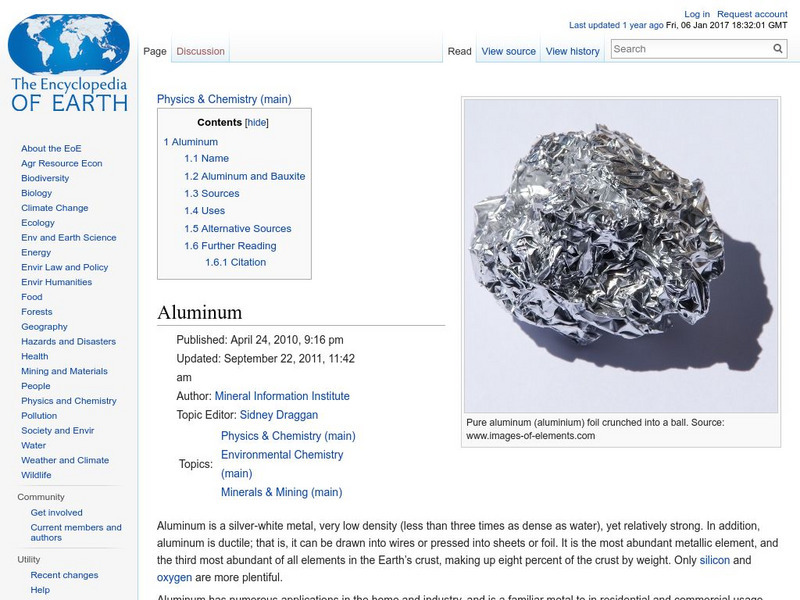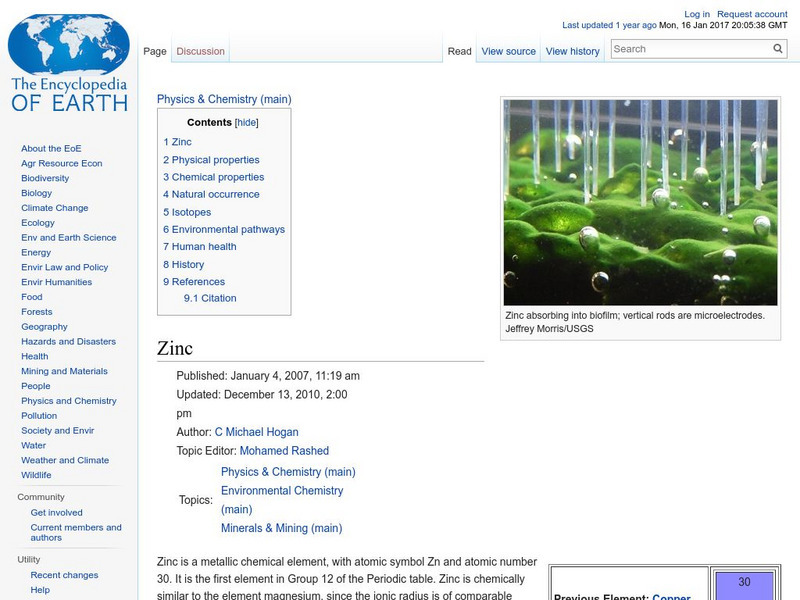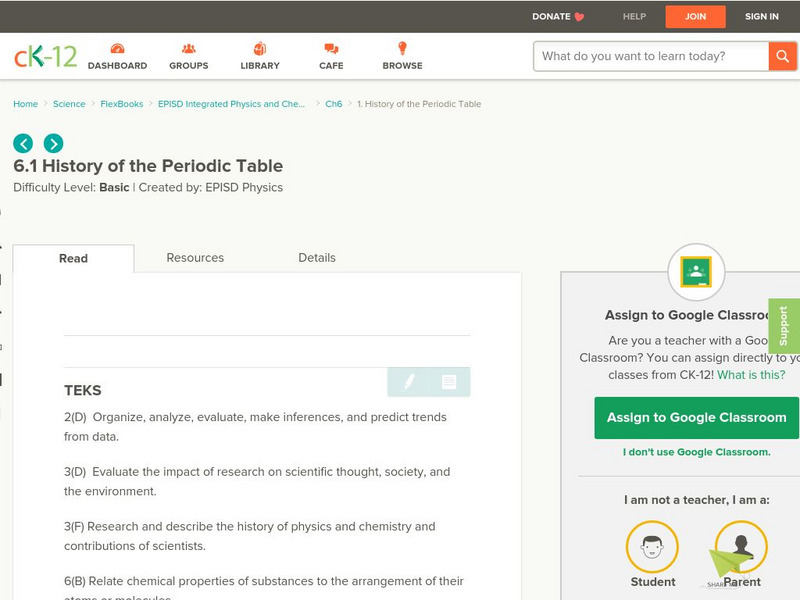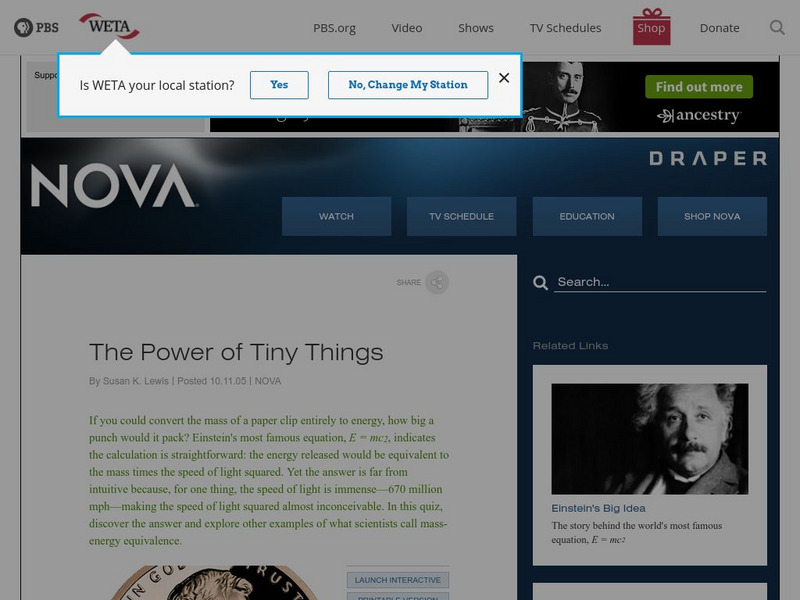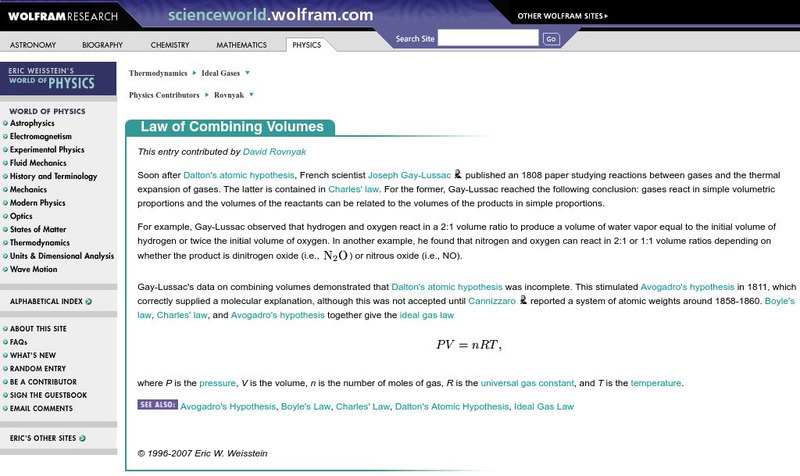Hi, what do you want to do?
Encyclopedia of Earth
Encyclopedia of Earth: Aluminum
Information about the element, Aluminum, atomic number 13. Covers physical and atomic properties, how abundant it is on the Earth, and permissible exposure limits. Also discusses the origin of its name, sources of aluminum, and uses for...
Encyclopedia of Earth
Encyclopedia of Earth: Mercury
Information about the element, Mercury, atomic number 80. Covers physical and atomic properties, where it is found, and health-related regulations. Also discusses its three main forms, uses for mercury, ways it spreads throughout the...
Encyclopedia of Earth
Encyclopedia of Earth: Zinc
Information about the element, Zinc, atomic number 30. Covers physical and chemical properties, how abundant it is on the Earth, where it occurs, isotopes, zinc in the environment, its role in human health, and the history of its use in...
Encyclopedia of Earth
Encyclopedia of Earth: Arsenic
Basic information about the element Arsenic, atomic number 33. Covers physical properties and properties, sources, how abundant it is on the Earth, uses, and toxicity.
CK-12 Foundation
Ck 12: History of the Periodic Table
[Free Registration/Login may be required to access all resource tools.] Students explore the history of the periodic table, and explain how the periodic table was originally organized, compared to the arrangement of the modern periodic...
PBS
Pbs Nova: The Power of Tiny Things
Have you ever wondered what would happen if you converted the mass of a paper clip into an amount of energy? In this informative quiz, discover the answer, and explore other examples of mass-energy equivalence.
California Institute of Technology
Guide to Snowflakes
No two snowflakes are the same, but they may have the same form. Learn about the basic forms of snowflakes as well as how some scientists classify them. Explore the site to find out other information as well.
California Institute of Technology
Things You Always Wanted to Know About Snow Crystals
Have you ever wondered if it's true that no two snowflakes are ever the same or why snow is white? Find out the answers to these questions and others here!
Wolfram Research
Wolfram Science World: Law of Combining Volumes
This site contains informaiton on the law of combining volumes. A formula is given and links to key terms.
Nobel Media AB
The Nobel Prize: James Chadwick Biographical
This sites provides a definitive biography of Chadwick presented by the Nobel (Prize) e-Museum.
CK-12 Foundation
Ck 12: Nuclear Stability and Binding Energy
[Free Registration/Login may be required to access all resource tools.] In this lesson, students learn how scientists study the properties of stable nuclei in order to draw generalizations about what makes a nucleus stable. They look at...
CK-12 Foundation
Ck 12: The Bohr and Quantum Models of the Atom
[Free Registration/Login may be required to access all resource tools.] Students explore how the study of the hydrogen emission spectrum led to the Bohr model of the atom, in which electrons exist in states of constant energy.
Curated OER
Image
This is the website of the Nuclear Physics Group at the University of Birmingham. There is information on research, degrees, seminars, etc.
Curated OER
Image
This is the website of the Nuclear Physics Group at the University of Birmingham. There is information on research, degrees, seminars, etc.
Environmental Chemistry
Environmental chemistry.com: Periodic Table Neodymium
EnvironmentalChemistry.com offers a thorough site all about the element neodymium.
Environmental Chemistry
Environmental chemistry.com: Periodic Table Neon
A great reference for information on neon. This is as thorough of a site as you are likely to find.
Environmental Chemistry
Environmental chemistry.com: Periodic Table Nickel
An incredibly thorough source for information on nickel.
Environmental Chemistry
Environmental chemistry.com: Periodic Table Nitrogen
An exceptionally detailed and helpful resource for all sorts of information on nitrogen.
Environmental Chemistry
Environmental chemistry.com: Periodic Table Oxygen
An incredibly thorough site with a wealth of basic information on oxygen. Highly recommended.
Environmental Chemistry
Environmental chemistry.com: Periodic Table: Osmium
A site that has it all. This is probably the best place to start looking for information or data on osmium.
Environmental Chemistry
Environmental chemistry.com: Periodic Table Palladium
An oustanding source of information for all sorts of general information on palladium.
Environmental Chemistry
Environmental chemistry.com: Periodic Table Samarium
As the name of this site implies, this is a huge source of elemental information. You are likely to find whatever you need to know about elements here.
Environmental Chemistry
Environmental chemistry.com: Periodic Table Sodium
As the name of this site implies, this is a huge source of elemental information. You are likely to find whatever you need to know about elements here.
Environmental Chemistry
Environmental chemistry.com: Periodic Table Strontium
As the name of this site implies, this is a huge source of elemental information. You are likely to find whatever you need to know about elements here.
Other popular searches
- Atomic Physics Bohr
- Atomic Physics Rutherford
- Sub Atomic Physics
- Atomic Physics "Elements
- Atomic Physics Elements
- "Elements" Atomic Physics
- Atomic Physics \"Elements





